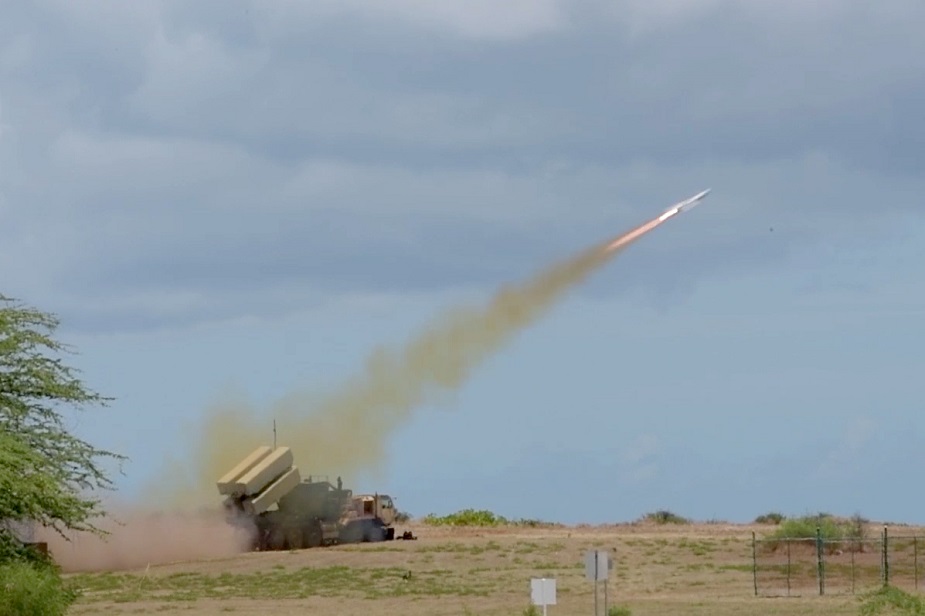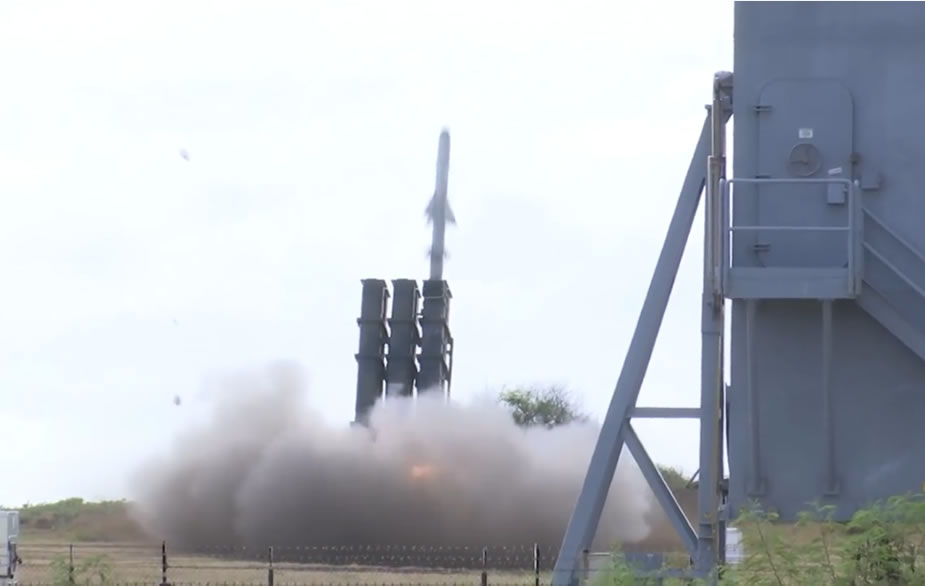Live fire from aircraft, a submarine, and land assets (including Japan's Type 12 SSM and Kongsberg's NSM) sank the decommissioned ex-USS Racine (LST-1191) July 12 north of Kauai, Hawaii, during the Rim of the Pacific (RIMPAC) exercise.
 A Naval Strike Missile (NSM) is launched from the back of a Palletized Load System (PLS) by the U.S. Army at Pacific Missile Range Facility Barking Sands. (U.S. Air Force)
A Naval Strike Missile (NSM) is launched from the back of a Palletized Load System (PLS) by the U.S. Army at Pacific Missile Range Facility Barking Sands. (U.S. Air Force)
Units from Australia, Japan, and the U.S. participated in the sinking exercise (SINKEX), which provided them the opportunity to gain proficiency in tactics, targeting and live firing against a surface target at sea.
“Today, we demonstrated the lethality and adaptability of our joint forces in the maritime environment”, said Adm. Phil Davidson, Commander, U.S. Indo-Pacific Command. “As naval forces drive our enemies into the littorals, army forces can strike them. Conversely, when the army drives our enemies out to sea naval firepower can do the same.”
The SINKEX featured live firing of surface-to-ship missiles by the Japan Ground Self-Defense Force and a Naval Strike Missile (NSM) from a launcher on the back of a Palletized Load System (PLS) by the U.S. Army. This marks the first time the U.S. Army and JGSDF have participated in a sinking exercise during RIMPAC.
(July 12, 2018) PACIFIC MISSILE RANGE FACILITY BARKING SANDS, Hawaii — U.S. Army and Japan Ground Self-Defense Force (JGSDF) members launch missiles from Pacific Missile Range Facility Barking Sands at the decommissioned ex-USS Racine (LST-1191), positioned at sea, during a sinking exercise as part of the Rim of the Pacific (RIMPAC) exercise.
This year was also the first time a Royal Australian Air Force P-8A Poseidon aircraft has participated in a SINKEX during RIMPAC.
“With numerous warships, allied submarines, multiple strike aircraft and multi-domain land forces participating, this SINKEX was an extremely valuable part of RIMPAC,” said Royal Canadian Navy Rear Adm. Bob Auchterlonie, deputy commander of the RIMPAC Combined Task Force. “SINKEXs are an important way for us to test our weapons and weapons systems in a way that provides our ships’ companies, our submariners, our aircrews, and our land forces with the most realistic training possible.”
Twenty-five nations, 46 ships, five submarines, and more than 200 aircraft and 25,000 personnel are participating in RIMPAC from June 27 to Aug. 2 in and around the Hawaiian Islands and Southern California. The world's largest international maritime exercise, RIMPAC provides a unique training opportunity while fostering and sustaining cooperative relationships among participants critical to ensuring the safety of sea lanes and security on the world's oceans. RIMPAC 2018 is the 26th exercise in the series that began in 1971.
 A Japanese Type 12 surface-to-ship missile (SSM-12) is launched by the Japan Ground Self-Defense Force from Pacific Missile Range Facility Barking Sands.
A Japanese Type 12 surface-to-ship missile (SSM-12) is launched by the Japan Ground Self-Defense Force from Pacific Missile Range Facility Barking Sands.
About Type 12 SSM
The Type 12 surface-to-ship missile (12式地対艦誘導弾) is a truck-mounted anti-ship missile developed by Japan's Mitsubishi’ Heavy Industries in 2012. It is an upgrade of the Type 88 Surface-to-Ship missile. The Type 12 features INS with mid-course GPS guidance and better precision due to enhanced Terrain Countour Matching and target discrimination capabilities. The weapon is networked, where initial and mid-course targeting can be provided by other platforms, and also boasts shorter reload times, reduced lifecycle costs, and a range of 108 nautical miles (200 km).
About NSM
The NSM is a fifth generation anti-sip missile, developed by KONGSBERG for the Norwegian Navy. NSM reached Initial Operational Capability on the new Norwegian Fridtjof Nansen Class frigates and the new Norwegian Skjold Class corvettes in 2012. It is also fielded by the Polish Navy (coastal defense batteries) and has been selected by the navies of Malaysia and Germany. NSM was also selected a few weeks ago as the winner of the U.S. Navy Over-The-Horizon Weapon System (OTH WS) competition.
NSM has an operational range of 185 Km (100 nautical miles) and a high subsonnic speed. It uses Inertial, GPS and terrain-reference navigation and imaging infrared homing (with target database).
Live fire SINKEX from land-based missiles and a submarine torpedo sinks the decommissioned USS Racine (LST-1191) on July 12, 2018 in the Pacific Ocean during Rim of the Pacific (RIMPAC) exercises.










